Barberry common - thorny bush, belonging to the Barberry family, is widely used for medicinal purposes, from ancient times to the present day. It is known that its fruits were used in ancient India and Babylon as a means for purifying the blood. Healing properties have almost all parts of the plant - roots, fruits, leaves, bark. Of particular value is the root of barberry, as it contains the greatest amount of berberine alkaloid, which has a diuretic and choleretic effect, which reduces arterial pressure and increases uterine contraction, as well as other beneficial substances. Barberry is grown not only in medicinal, but also in decorative purposes for decorating parks and gardens. In nature, it is common in Europe, the Caucasus, North America and Central Asia. In people, barberry common because of the sour taste of berries is often called acid.
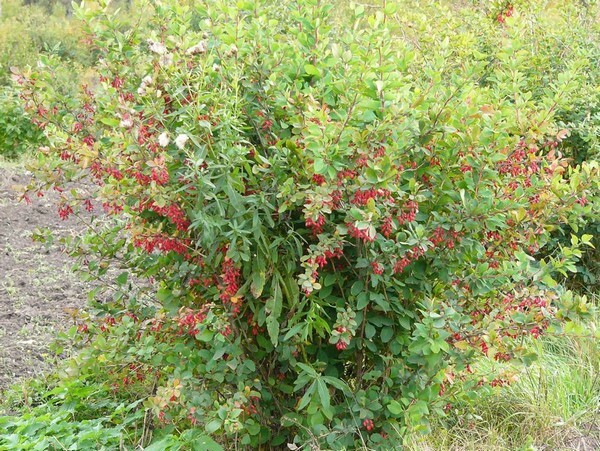
Botanical description
Barberry common is a perennial shrub, in the wild it grows on dry and stony slopes, limestones, forest clearings and fringes, sometimes it can be found in valleys of rivers and on seashores. It is not picky for the soil, it is resistant to frost, heat and drought. It prefers dry and bright terrain. Propagates by rhizomes and seeds.
The root system is superficial, powerful, allowing the plant to be well anchored on steep slopes. Rhizomes are branching, creeping, lignifying, thanks to them the plant can form groups of several dozen bushes. The roots are coarse-grained, on the fracture are yellow.
Bushes of barberry have a rounded shape, their height is no more than 3 m, usually about 1.5 m. Shoots erect. The bush is strongly branched, the branches are thin. Elongated shoots instead of leaves have spines of sheet origin up to 2 cm long. The trunks and old branches of the bush are covered with grayish bark, and the bark of young branches has a yellow-brown or yellow-gray color.
The leaves are thin, located alternately on short petioles, have small stipules. The size is small, with a width of up to 2 cm and a length of up to 4 cm, ovoid. The edges of the leaves are finely finned with thin prickly cilia. In autumn they acquire a beautiful purple color, which increases the decorative value of the plant.
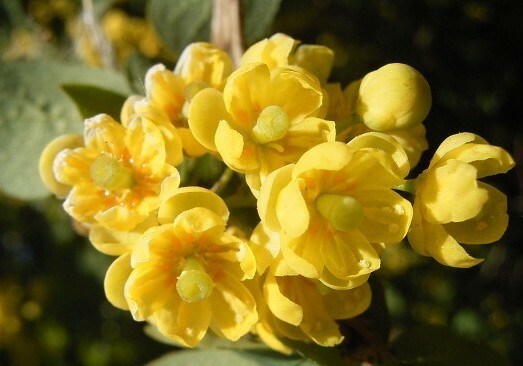
The flowering period falls on April-May and is about three weeks. Flowers of bright yellow color, form inflorescences of axillary brushes( up to 6 cm in length), including 15 to 25 pieces of flowers. Are located on the tops of shortened leafy shoots. Each individual flower in the inflorescence is on a pedicel about 0.5-1 cm long. The calyx consists of 6 sepals, arranged in three in two circles. Corolla up to 1 cm in diameter, includes 6 obovate petals. Flowers are bisexual, have 6 stamens and a pestle. At the base of the flower are bright orange nectaries.
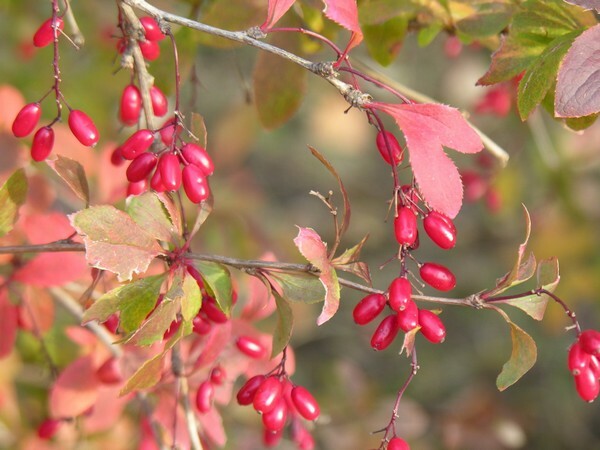
Fruits ripen in early autumn. They are oblong bright red juicy, acidic berries up to 12 mm long. Each berry contains 2 to 3 large seeds of dark brown color, an elongated flattened form on the top with a length of 4-6 mm.
Warning: The unripe fruit of ordinary barberry is poisonous!
Chemical composition of
The active substances of the roots of barberry are isoquinoline alkaloids, of which there are about 10( berberine, palmitin, columbamin, yatroricin, oxyacanthine, leontin, etc.).Among them, the most important is berberine, whose content in the cortex of roots reaches 9.5%.In addition, the root of the plant is rich in tannins, vitamins( C and E), carotene, organic acids. It also contains essential oil.
The healing properties of
The drugs from the root of barberry have the following action:
- choleretic;
- is an anti-inflammatory;
- antimicrobial;
- astringent;
- hemostatic;
- is a diuretic;
- is an analgesic;
- is antimicrobial.
The listed medicinal properties of the barberry root allow using it in inflammatory diseases of the liver, pancreas, gall bladder, cholelithiasis and peptic ulcer, to increase appetite and relieve gastric spasm. The funds from it help with inflammation in the organs of the genitourinary system and in the upper respiratory tract, edema, edema, heart rhythm disturbances. They are used to stop bleeding, particularly during uterine bleeding in the postpartum period, to stimulate uterine contractions after childbirth, with gastrointestinal infections, dysentery, diarrhea, to relieve pressure and strengthen the heart muscle. It has been established that the berberine alkaloid, which is a part of the plant roots, has antitumor activity and can be used in the complex therapy of some malignant neoplasms.
External barberry root in the form of a decoction is effective for rinses and lotions for various lesions of the skin( wounds, ulcers) and inflammation in the oral cavity( gingivitis, periodontitis, stomatitis, tonsillitis).It helps with chronic joint diseases, gout, lumbago, rheumatism, neuralgia.
From the root of barberry in the form of hydrosulfate, the alkaloid berberine, which is part of some medicinal preparations, is isolated. Effective methods of obtaining this compound synthetically have not yet been developed.
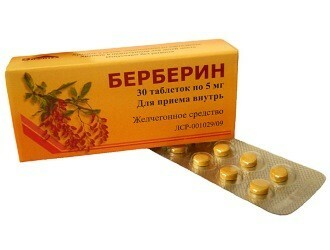
Interestingly: The flowers of barberry ordinary give off nectar, which honey bees collect. The honey obtained on its basis has a golden yellow color, a delicate taste and a pleasant aroma.
Procurement of raw materials
The preparation of the roots of barberry is carried out in the spring before the leaves are blossomed or in the autumn after the ripening of the fruit. To save thickets of shrubs, when collecting roots, you should dig out only every second bush. Repeated billets on the same site are produced no earlier than in 5 years. The excavated roots shake off the remains of the soil, remove impurities, rotted and blackened parts. Then cut them into pieces about 10 cm long, split along into two parts and dried, spreading a thin layer on fabric or paper. Drying can be done in a ventilated room, outdoors under a canopy or in dryers, the temperature in which should not be more than 45 ° C.When collecting raw materials it should be taken into account that only roots whose diameter does not exceed 6 cm are suitable for medical purposes.
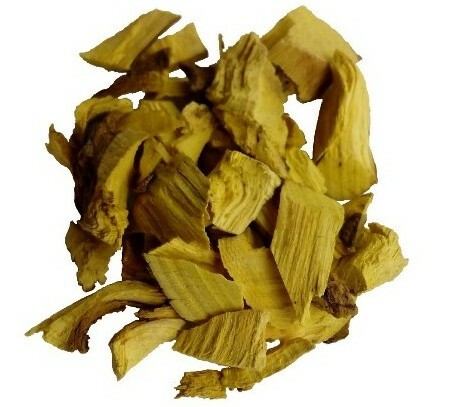
Dried roots have a lemon-yellow color on the fracture and brownish outside, a bitterish taste and a peculiar faint odor. Keep them in bags. Shelf life is 3 years.
Important: Barberry roots can not be washed with water, since a significant part of their main active substance berberine is lost, which dissolves fairly well in water.
Ways of using
The barberry root has found application in the form of decoctions, infusions and alcohol tinctures, which are used externally or are consumed inside.

Broth for bruises, rheumatism and joint pain
Dried roots, branches and bark barberry are crushed and mixed in equal proportions. To ½ tsp.200 ml of milk are added and boiled for 30 minutes. Then filter and take inside 5 ml three times a day for dislocations and sprains, as well as externally in the form of lotions with bruises and joint diseases.
Broth for gallstones in the gall bladder
Bark and roots of the plant for 1 tbsp.l.put into a saucepan, add 300 ml of water and boil for half an hour, then gradually cool, filter, add boiled water to the original volume. Take this drug three times a day for 50 ml.
Infusion of roots with hepatitis and kidney diseases
Put dried dry roots of barberry( 2 tablespoons) in a thermos and brew 400 ml of boiling water. Insist and use in the course of the month for 100 ml 3 times a day.Decoction for external use
Roots( 2 ½ tsp) pour 300 ml of boiling water, boil for 5 minutes. Then it is filtered and used for douching and baths for inflammation of the genital organs in women, rinses for inflammation of the gums, diphtheria, rinses with inflammation of the eyes and lotions for wounds and eczema.
Alcohol tincture for bleeding and for contraction of the uterus after birth
Roots( 50 g) are ground and 100 ml of alcohol are added. Insist in the dark place for 15 to 18 days. After the time has elapsed, the obtained product is filtered and taken 30 drops three times a day.
Broth in pleurisy, tuberculosis, neuralgia and rheumatism
A mixture of bark( 10 g) and barberry roots( 15 g) is poured with 300 ml of cold water, placed on a water bath and held there for half an hour. After that, cool, filter, bring the volume to the original. Consume 50 ml three times a day.
Precautions
For the use of funds from the root of barberry, there are contraindications, so before starting treatment should consult a doctor. These include:
- pregnancy;
- reduced pressure;
- menopause;
- bleeding caused by impaired ovarian function;
- bleeding in the postpartum period if there is incomplete separation of the placenta;
- children's age;
- cirrhosis;
- spasm of cerebral vessels;
- thrombophlebitis, a tendency to thrombosis.
During the reception of funds based on the root of barberry the following adverse reactions are possible:
- vasospasm;
- thrombogenesis;
- exacerbation of chronic cardiovascular diseases;
- muscle cramps;
- disorder of stool( constipation).
Therapeutic properties and methods of application of barberry:
